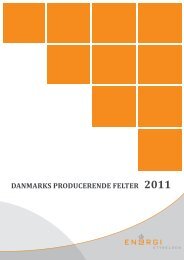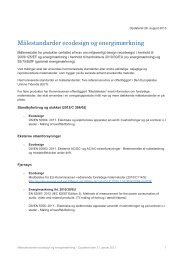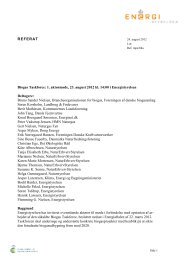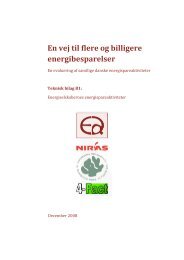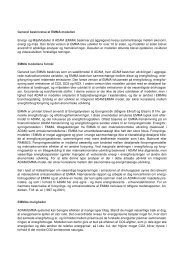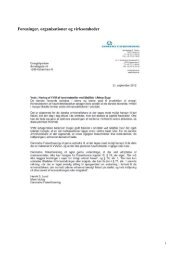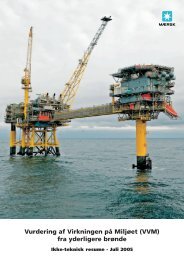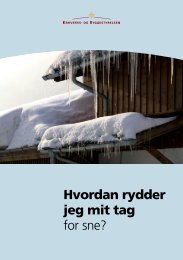Benthic Communities at Horns Rev Before, During and After Con
Benthic Communities at Horns Rev Before, During and After Con
Benthic Communities at Horns Rev Before, During and After Con
Create successful ePaper yourself
Turn your PDF publications into a flip-book with our unique Google optimized e-Paper software.
<strong>Horns</strong> <strong>Rev</strong>. <strong>Benthic</strong> communities Page 52<br />
In the splash zone of the monopiles, a dense cover of the filamentous green algae (Urospora<br />
penicilliformis) was only observed in spring 2003 whereas Cladophora was observed<br />
in rel<strong>at</strong>ively low coverage in autumn 2003 <strong>and</strong> autumn 2005. In 2004 <strong>and</strong> 2005, the<br />
veget<strong>at</strong>ion of filamentous algae was generally replaced by a distinct green/brown co<strong>at</strong>ing<br />
of microscopic green algae <strong>and</strong> di<strong>at</strong>oms.<br />
Just bene<strong>at</strong>h the surface to approxim<strong>at</strong>ely 2 metres below the sea surface, r<strong>at</strong>her dense<br />
m<strong>at</strong>s of the filamentous brown algae (Pilayella littoralis/Ectocarpus) were found. The<br />
coverage of Pilayella littoralis was especially high in 2003 <strong>and</strong> 2005 <strong>and</strong> this species was<br />
almost exclusively found in the spring surveys (Figure 3.12). Species of Ulva cl<strong>at</strong>hr<strong>at</strong>a<br />
<strong>and</strong> Ulva prolifera (Enteromorpha spp.) were rel<strong>at</strong>ively domin<strong>at</strong>ing in this zone with the<br />
highest coverage of these species being generally found in the autumn. The green algae<br />
(Ch<strong>at</strong>omorpha linum) <strong>and</strong> the red algae (Polysiphonia fibrillosa) were found <strong>at</strong> most turbine<br />
sites in 2005 with small tufts of the common red porphyra algae (Porphyra umbilicalis)<br />
being found <strong>at</strong> some turbine sites. The seaweeds (Petalonia fascia <strong>and</strong> Petalonia<br />
zosterifolia) were also typically found in this depth zone but in rel<strong>at</strong>ively low coverage.<br />
Veget<strong>at</strong>ion coverage declined with increasing depth, which was pronounced for the most<br />
abundant species, Pilayella littoralis/Ectocarpus <strong>and</strong> Ulva (Enteromorpha) (Figure 3.12),<br />
which were found 4-6 m below the sea surface. In 2005, Ulva lactuca was found 6-8 m<br />
below the sea surface. Petalonia fascia <strong>and</strong> Polysiphonia fibrillosa were occasionally<br />
found 4-6 m <strong>and</strong> 2-4 m below the sea surface.<br />
0-2 m<br />
2-4 m<br />
4-6 m<br />
6-8 m<br />
8-10 m<br />
Ectocarpus/Pilayella Coverage monopiles<br />
March 03<br />
Sept. 03<br />
March 04<br />
Sept. 04<br />
March 05<br />
Sept. 05<br />
0 5 10<br />
Rel<strong>at</strong>ive coverage<br />
15 20<br />
0-2 m<br />
2-4 m<br />
4-6 m<br />
6-8 m<br />
8-10 m<br />
Ulva spp. Coverage monopiles<br />
March 03<br />
Sept. 03<br />
March 04<br />
Sept. 04<br />
March 05<br />
Sept. 05<br />
0 5 10<br />
Rel<strong>at</strong>ive coverage<br />
15 20<br />
Figure 3.12.Depth distribution <strong>and</strong> mean rel<strong>at</strong>ive coverage of filamentous algae (Ectocarpus/Pilayella) <strong>and</strong><br />
Ulva spp. along transects <strong>at</strong> monopiles in 2003-2005.<br />
3.3.2. Epifauna<br />
The total number of species associ<strong>at</strong>ed with the hard bottom structures <strong>at</strong> <strong>Horns</strong> <strong>Rev</strong> has<br />
increased gradually from the first surveys in 2003 to the surveys in 2005.<br />
Of the 111 total invertebr<strong>at</strong>e species registered <strong>and</strong> observed during the monitoring of the<br />
hard bottom structures, only 37 species/taxons could be characteristically found as n<strong>at</strong>ive<br />
infauna or mobile fauna in the area before the establishment of the offshore wind farm <strong>at</strong><br />
<strong>Horns</strong> <strong>Rev</strong>. Only 14 species/taxons were not sampled or identified in the quantit<strong>at</strong>ive<br />
samples. Some of these species were occasionally <strong>and</strong> only observed by divers during the<br />
transect surveys (Appendix 2.1). It was mainly very mobile species such as crabs <strong>and</strong> larger<br />
species like the common whelk. Other very common species, such as the plumose<br />
Doc. No. 2572-03-005 rev. 4




